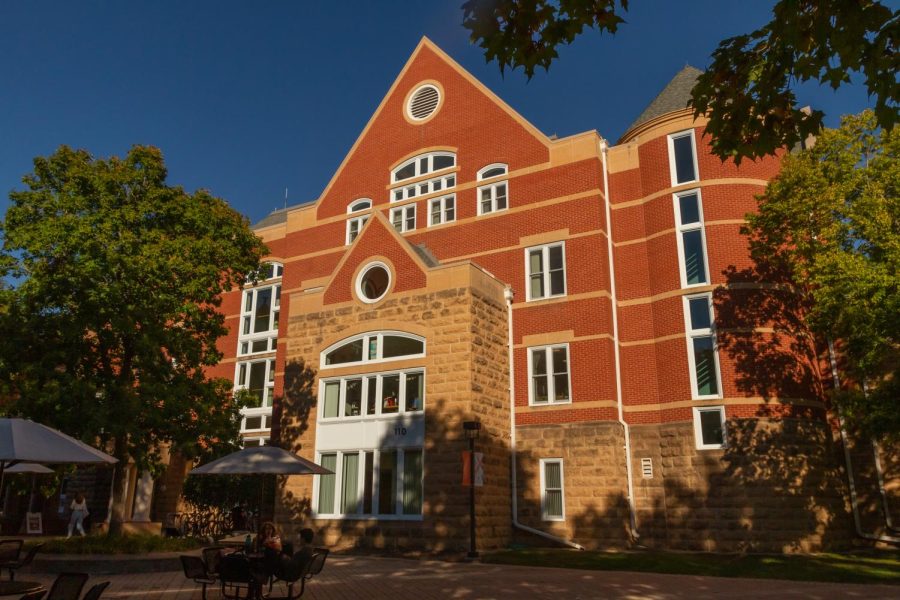Summer improvements: campus construction and renovations
September 29, 2022
The mass student return to the Macalester campus is typically met with the finishing of construction projects that occurred during the summer, and various complaints from students and faculty when these projects interfere with their day-to-day lives. However, most of the Macalester population may not notice the intensive thought and behind the scenes work that it takes to keep the campus running.
According to Assistant Vice President of Facilities Services Nathan Lief, over nine major construction projects were completed in different buildings across campus this summer alone. Some of these included the re-roofing of the library and campus center, remodeling of a portion of Kagin Commons and the replacement of the chemical hood exhaust fans within Olin Rice.
“Much of what we do is invisible to the rest of campus because it happens in mechanical spaces or behind walls,” Lief wrote in an email to The Mac Weekly.
Construction projects such as these occur every summer, just to keep up with a base turnover rate for infrastructure such as carpet, roofs, elevators and more. Failure to keep up with this turnover rate each summer results in a backlog of projects, should Facilities Services fall behind, referred to as deferred maintenance.
“Having too much deferred maintenance can result in future maintenance and operations costs skyrocketing,” Lief wrote. “As building systems age, they require more and more maintenance and repairs to keep them functional. It’s a lot more cost effective to replace items right before they are about to fail than after.”
Grounds work also occurs during the summer months, but not much was accomplished this past summer in comparison to past years. This is largely due to a lack of student help over the summer, since they regularly employ four to eight student workers during the academic year and summer months.
“Landscaping projects rely on student workers to ‘help with larger landscape redesigns,” Lead Grounds Person Michael Frazier wrote in an email to The Mac Weekly.
Macalester facilities creates 10-year plans that include predicted maintenance and replacement dates of everything around the campus. They also conduct regular condition inspections to ensure critical components of buildings are properly maintained and replaced on time.
“We prioritize all of this work based on a number of factors, like overall cost, whether there is a potential safety issue, a compliance or code violation, an end of life situation with critical infrastructure, a business need that must be met, does the project save energy, is there a financial payback, etc.” Leif wrote.
The budgeting process for determining constructions and building maintenance funding begins by looking at the current 10-year plan as well as gathering information from building evaluations and system failure predictions. A list is compiled of critical to non-critical projects and funding is then requested.
“There are also times when additional special funding is directed at specific projects,” Lief wrote. “For instance, the college might receive a grant or donation for a specific project. At times, the college has provided additional project funding from reserves and other sources to address energy improvements or very costly projects where the budget is beyond what the normal funding mechanisms can support.”
The grounds funding is a little different. Most of the funding that goes towards operating and maintaining the greenspace and landscaping of the school comes from the grounds operating budget. However, in special scenarios, funding can be pulled from a separate budget at the start of the fiscal year. When deciding what grounds projects to prioritize, the grounds team works sustainably, with a focus on green spaces, areas for bees and native plants.
“We try to pick areas that can be converted from turf to pollinator or native gardens,” Frazier wrote. “Areas where turf grass struggles is typically our first focus for converting. Most plantings are steered towards pollinator gardens with an emphasis on native plants. However, we try to diversify the plant species as well.”
Additionally, the grounds team is shifting their landscaping practices to be more environmentally conscious in terms of equipment and pesticide use.
“Over the last three years we have reduced our use of pesticides where we can, took advantage of a grant from the State of Minnesota to purchase $10K worth of battery powered landscape tools and we have started to plant clover in turf areas to attract and help the bee population,” Frazier wrote.
The upkeep of buildings on Macalester campus is extensive and very precise. For both grounds and building maintenance of the campus, a lot of careful planning goes into renovations each summer and during the year.













